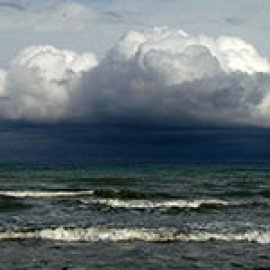Synergy in Ocean Innovation
-
English
-
ListenPause
I’m Peter Neill, Director of the World Ocean Observatory. Once upon a time I wrote a story about a wise man staring out to sea whose vision brought followers to the shore in search of wisdom. One day his thoughts seemed to stall, mind emptied, as if what he knew was no longer valuable or pertinent. Frustrated and bereft, he felt that he had no purpose or future until a child invited him to stand up, stretch his limbs, and turn around. Seated again, in the same place, with the same view of the ocean horizon, he awakened to a new vision, an exhilarating prospect conceived with the same knowledge of his past views, but now again vital and useful for those who came to learn. This clumsy parable points to the dangers of consistency and complacency, of minds closed by routine and fear of change, and most importantly to renewal and re-invention oftentimes using the tools in hand to create new from old, an optimistic, forward-looking process that has characterized human progress for centuries. Let me give you two examples of the synergy between known technologies toward new possibility and positive outcome. The complexity and cost of ocean research has demanded more efficient and economical research tools and the use of stationary or free-circulating data collection buoys which has become the heart of ocean data collection and observation. But these too, like their forbears, tethered submersibles and costly research vessels, have been advanced to become remote underwater vehicles that can follow a programmed trajectory and research collection plan. A new technology, geothermal energy generation, making electricity through the expansion and contraction of a non-toxic material generated by changing ocean temperature to charge and maintain batteries that propel the vehicle through its dives, upload its collected data via satellite to a station ashore, and broadcast its GPS location for recovery by ship when the mission is completed. Thus we have here a link between advanced data collection and novel sustainable energy generation. This project is the result of collaboration between Cal Tech and NASA’s Jet Propulsion Laboratory, the technology licensed to a private company called Seatrek which is pursuing its further development and use. Let’s take another example on a much larger scale. Many nations of the world have invested heavily and successfully in wind generated energy, windmills often located in coastal and offshore areas where wind velocity and consistency is at its highest. The success of this technology, coupled to solar generation, has vastly increased the market share of alternative energy generation, with some countries reporting successive days of and sometimes 100% contribution to the national capacity requirements. At the same time, the world has realized a critical fresh water crisis that has challenged the stability and security of cities often located along the coast. In many such cases, water managers have turned to desalination technology to augment diminishing supply. That crisis is estimated to increase and the demand for efficient desalination will only expand exponentially. The process is expensive, specifically because of the electrical demand to drive the pumps and equipment. Here again, suddenly, the technology link seems obvious – the connection between coastal wind power and coastal desal plants in drought-stricken and/or urban areas, so many of which are located directly by the sea. The shift is already occurring. This project is being promoted by the Global Clean Water Desalination Alliance to many national and city governments and private companies and developers as a practical, innovative response to a desperate challenge. Think of what can come of this linkage: an entirely new system for emissions-free, non-fossil fuel-based energy for power to meet the universal public necessity for adequate fresh water by which to survive. Think of the future implication of fresh available water for drinking, bathing, and maintaining our homes and communities. As with my wise man, the answer is obvious, there before our very eyes, everything we need to invent a future that will provide and sustain, with wisdom known and available, but only when we have stood up and turned round, optimistically, to see. Once upon a time is now. We will discuss these issues, and more, in future editions of World Ocean Radio. World Ocean Radio is distributed by the Public Radio Exchange and the Pacifica Network for use by college and community radio stations worldwide. Find us wherever you listen to your favorite podcasts and at world ocean observatory dot org. [outro music]
This summer we are revisiting some of our favorite World Ocean Radio episodes that highlight optimism for the ocean. In this episode we discuss two examples of innovative practices and their relationships to each another: 1. ocean research and data collection and the connection to geothermal energy generation, and 2. offshore wind energy and its relationship to desalination plants and the energy required to operate.
About World Ocean Radio
5-minute weekly insights dive into ocean science, advocacy and education hosted by Peter Neill, lifelong ocean advocate and maritime expert. Episodes offer perspectives on global ocean issues and viable solutions, and celebrate exemplary projects. Available for syndicated use at no cost by college and community radio stations worldwide.
Photo
Mostafameraji
commons.wikimedia.org/wiki/User:Mostafameraji
Creative Commons 4.0 International
Resources from this Episode
Cal Tech NASA Jet Propulsion Lab
Seatrek
Global Clean Water Desalination Alliance
- Login to post comments



